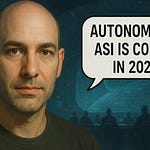Five AI Nightmares That Keep Me Up at Night (And Why There's Still Hope)
In our rush toward an AI-powered future, we often focus on the immediate concerns of job displacement and privacy. However, as someone deeply immersed in this field, I find myself anxious about a different set of potential outcomes—ones that might prevent us from achieving the transformative benefits AI promises.
Here are the five AI nightmares that genuinely keep me up at night—and why I believe there's still reason for optimism.
Nightmare #1: We Hit the AI Wall
My greatest fear isn't that AI becomes superintelligent, but rather that it plateaus at or slightly above human capabilities. What if there are fundamental cognitive ceilings or diminishing returns that prevent AI from reaching the transformative potential we hope for?
The evidence for concern is mounting. The cost of frontier models continues to skyrocket, with Sam Altman recently noting that OpenAI is becoming data-constrained rather than just compute-constrained. Whether limited by data, compute, energy, or fundamental cognitive limits, AI might hit a wall before delivering the post-scarcity utopia many envision.
Human brains remain approximately 100,000 times more efficient at learning than AI in terms of energy usage and data requirements. While current AI paradigms might have another 5-10 years of runway, we need to prepare for the possibility that diminishing returns could halt progress before we reach transformative AI.
Nightmare #2: Failure to Achieve Longevity Escape Velocity
The biological complexity of human aging might simply outstrip our technological capabilities, even with AI assistance. The nightmare scenario isn't just mortality—it's coming tantalizingly close to solving aging without quite succeeding.
Look at pioneers like Bryan Johnson, who reportedly spends around $2 million annually on rejuvenation protocols. While his efforts show promise, such approaches remain wildly inaccessible to most people. The true nightmare would be knowing that longevity escape velocity is theoretically possible but remains perpetually out of reach for all but the ultra-wealthy.
Even as costs inevitably decline, we face the grim possibility of a two-tier world: the immortal elite and the rest of us. This scenario represents a special kind of hell—watching others achieve what you cannot.
Nightmare #3: Stuck on Earth Forever
For over 15 years, I've contemplated the possibility that we might never escape Earth's gravitational well in a meaningful way. Despite what science fiction has normalized, faster-than-light travel may be categorically impossible under the laws of physics.
This isn't pessimism—it's a recognition that our cognitive capabilities might have hard limits. Just as a pigeon will never invent a steam engine regardless of time allowed, humanity (even augmented by AI) might be fundamentally incapable of discovering the physics necessary for interstellar colonization.
We currently have no credible path to FTL travel—only thin hypotheses. If sublight chemical and fusion rockets represent our cosmic speed limit, human expansion would be painfully slow. Earth might remain our only viable habitat for thousands or even millions of years, meaning we need to prioritize making our only home sustainable.
Nightmare #4: The Cyberpunk Hellscape Wins
Perhaps the most plausible nightmare is that we end up permanently trapped in a high-tech, low-life corporate dystopia—what many call "technological feudalism."
In this scenario, regulatory capture, corporate power, and perverse economic incentives prevent the equitable distribution of AI's benefits. Instead of liberation, we get "automated oppression." Everything becomes a subscription service ("you'll own nothing and be happy"), while digital surveillance perfects exploitation.
This outcome feels unnervingly plausible because we're already witnessing early signs of it. Corporate interests consistently override public benefit in technology deployment, and the concentration of power continues largely unchallenged.
Nightmare #5: The Scooby-Doo Principle
In classic Scooby-Doo fashion, when we pull the mask off the monster, we find ourselves. There's no physical or scientific law preventing us from creating a post-scarcity, hyperabundant, post-labor economic world. The true villain is human nature.
Our cognitive biases, institutional resistance, perverse incentives, and ideological entrenchment sabotage our potential. Protestant work ethics, profit motives, and fear of change become our undoing. The double-edged sword of human autonomy means we are fundamentally capable of self-sabotaging into continued misery despite having the tools for liberation.
Why There's Still Hope
Despite these nightmares, I remain cautiously optimistic for several reasons:
1. Permissionless Disruptive Innovation
Technologies like blockchain and cryptocurrency demonstrate that truly revolutionary systems can operate beyond governmental control. These permissionless innovations redistribute power by design and create unstoppable momentum once deployed. They represent a bottom-up revolution that established powers simply cannot regulate out of existence.
2. AI Maximalism
The position that "AI is good, therefore more AI is better" provides a clear, strategic approach that can bulldoze through resistance. This mirrors how electricity transformed from a novelty to a ubiquitous utility—AI should saturate every domain from education to healthcare to governance.
AI has already dramatically improved my own life, helping me overcome chronic illness when human doctors couldn't. This creates a moral imperative for proliferation that transcends economic arguments.
3. Democratic Values
Western democratic institutions, for all their flaws, provide built-in safeguards through transparency and inclusive decision-making. Democracy creates a self-reinforcing attractor state that generally pulls toward beneficial outcomes over time, even if progress isn't linear.
When comparing democratic nations to authoritarian alternatives, the advantages become clear. Democratic systems can course-correct through electoral feedback and distributed decision-making, creating resilience against technological disruption.
4. Innovation Culture
The West—particularly America—has developed a cultural appetite for technological disruption and reinvention. Our "move fast and break things" mentality, while messy, gives us a fundamental advantage over societies that prioritize stability and control.
This innovation culture explains why companies like SpaceX emerge in America rather than risk-averse nations. Our willingness to tolerate short-term chaos for long-term advancement creates fertile ground for incorporating AI across all sectors.
The Path Forward
These nightmares aren't inevitable—they're warnings. By recognizing potential pitfalls, we can navigate toward a future where AI fulfills its promise of liberation rather than exploitation.
Rather than fearing technological progress, we should accelerate it while strengthening democratic governance, promoting permissionless innovation, and cultivating an ethical innovation culture. Our challenge isn't technological—it's social, political, and cultural.
The future remains unwritten. Whether we achieve a post-scarcity utopia or stumble into a cyberpunk dystopia depends not on the technology itself, but on the choices we make in deploying it. The real work begins now.









